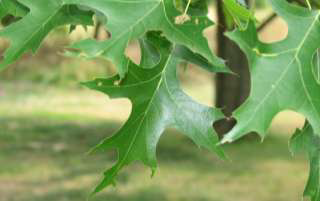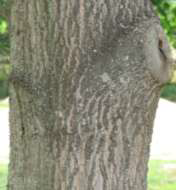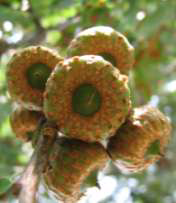 Red Oak
Red Oak
(Quercus rubra L.)
|
Classification |
| Kingdom: |
Plantae |
| Division: |
Magnoliophyta |
| Class: |
Rosopsida |
| Order: |
Fagales |
| Family: |
Fagaceae |
| Genus: |
Quercus |
| Species: |
Q. rubra |
 Characteristics: The Red Oak is a large tree with a rounded crown of stout, spreading branches. It ranges from 60 to 90 feet in height and the diameter of the trunk ranges from 1 to 2.5 feet. The bark is dark gray or blackish, rough, and furrowed in scaly ridges, with a reddish inner bark. The egg-shaped acorns of this species range from 5/8 to 1 1/8 inches in length. Less than a third of the acorn is enclosed by a broad cup of reddish-brown, blunt, tightly overlapping scales. The acorns mature in their second year.
Characteristics: The Red Oak is a large tree with a rounded crown of stout, spreading branches. It ranges from 60 to 90 feet in height and the diameter of the trunk ranges from 1 to 2.5 feet. The bark is dark gray or blackish, rough, and furrowed in scaly ridges, with a reddish inner bark. The egg-shaped acorns of this species range from 5/8 to 1 1/8 inches in length. Less than a third of the acorn is enclosed by a broad cup of reddish-brown, blunt, tightly overlapping scales. The acorns mature in their second year.
Habitat: Red Oak grows in a wide variety of soils, including moist, loamy, sandy, rocky, and clay soils. It can be found in mixed hardwood forests, but often forms pure stands.
 Range: It has a broad range, from western Ontario and Cape Breton Island to Georgia, and southeast Oklahoma to Minnesota.
Range: It has a broad range, from western Ontario and Cape Breton Island to Georgia, and southeast Oklahoma to Minnesota.
Native American Uses: The Red Oak bark was used for dysentery and chewed to treat mouth sores; an infusion was taken to treat asthma. The bark was also used as an antiseptic and an emetic. Red Oak was also used to make baskets, cooking tools, and building materials. It was commonly used to suppress severe coughs, but bark infusions also served as a dietary aid. This species was utilized by the Cherokee, Delaware, and Rappahannock Indians.
Colonial Uses: The colonists used the Red Oak to make woven chair bottoms, cooking tools, including using the leaves used to wrap dough for bread making. The wood was also used for firewood.
Modern Uses: This species is the most important lumber tree of the Red Oak group. Most are used for flooring, furniture, millwork, railroad cross-ties, mine timbers, fence posts, pilings, and pulpwood. The Red Oak is one of the most rapidly growing oaks and its dense foliage and good form make it a popular shade tree. In addition, it transplants easily, is hardy in city conditions, and endures cold temperatures well.